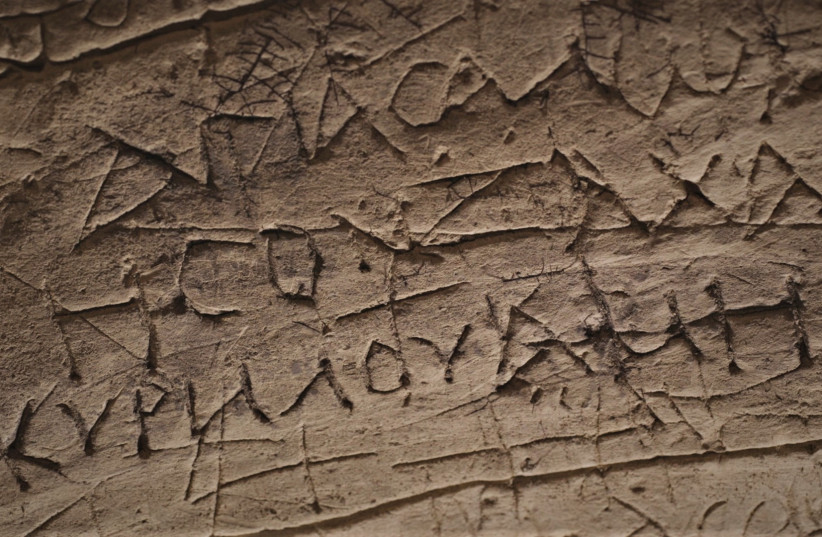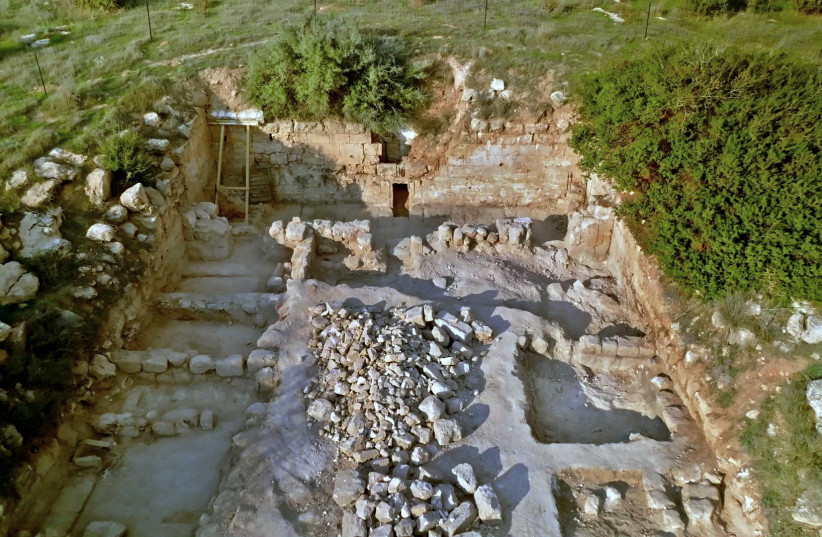by Judy Siegel Izkovitch
A chapel at the site was dedicated to Salome, the midwife from Bethlehem who was called to participate in the birth of Jesus.
 |
The Greek dedication inscription to Salome at a burial cave
(photo credit: EMIL ALADJEM/ISRAEL ANTIQUITIES AUTHORITY)
|
A 2,000-year-old family tomb – one of the most elaborate ever found in Israel – has been uncovered in an archaeological excavation at the Salome Cave in the Lachish Forest.
Evidence for centuries-long veneration of the site was uncovered, indicating that an esteemed person from a prominent family in the Second Temple-period was thought to be buried there.
The cave forecourt was excavated as part of the Judean Kings’ Trail Project, led by the Israel Antiquities Authority (IAA), the Ministry for Jerusalem and Heritage and the Jewish National Fund (JNF).
The cave was in use in the Byzantine and early Islamic periods, becoming known as the Salome Cave, due to popular tradition that identified it as the burial place of Salome, the midwife who assisted in the birth of Jesus. The excavation of the courtyard uncovered a row of shop stalls that, according to the excavators, sold or hired out clay lamps.
“In the shop, we found hundreds of complete and broken lamps dating from the 8th and 9th centuries CE,” said Nir Shimshon-Paran and Zvi Firer, excavation directors in the IAA’s southern region.
“The lamps may have served to light up the cave, or as part of the religious ceremonies like the candles distributed today at the graves of righteous figures and in churches,” he added.
The burial cave was first discovered 40 years ago by antiquity looters who broke into the cave, after which an archaeological excavation was carried out by Prof. Amos Kloner of the Antiquities Department.
The cave comprised several chambers with multiple rock-hewn burial niches and broken ossuaries (stone boxes for keeping bones), attesting to the Jewish burial custom.
The Jewish custom of secondary burial in stone ossuaries is well-known in archaeology but the surprise was the adaptation of the cave into a Christian chapel. Judging by the crosses and the dozens of inscriptions engraved on the cave walls in the Byzantine and Early Islamic periods, the chapel was dedicated to the sacred Salome.
Who was Salome?
“The name Salome (or in Hebrew: Shalom or Shlomit) was a common Jewish name in the Second Temple-period and was also known in the Hasmonean and Herodian families,” Paran and Firer said.
“According to Christian tradition, Salome was the midwife from Bethlehem who was called to help deliver Jesus. She could not believe that she was asked to help in the birth of a virgin’s baby and her hand became dry and was healed only when she held the baby’s cradle,” the two added.
While the cave itself was excavated years ago, the IAA now is specifically exposing the elaborate forecourt, which extends over 350 sq.m., is surrounded by ashlar (hewn, square) stone walls and has stone slab and mosaic floors.
The entrances leading into the cave and the interior chapel were exposed, some of the stones carved with fine decorative vegetal designs, including rosettes, pomegranates and acanthus vases that are characteristic Jewish features.
The forecourt and the cave itself attest that the family tomb belonged to a wealthy Jewish family who put much effort into preparing the cave. It is noteworthy that the court leading into burial caves was usually hewn from the rock, and not elaborately built of ashlar masonry as this forecourt, the team said.

The veneration of Salome and the use of the forecourt and the cave continued into the ninth century CE, after the Muslim conquest. Some of the inscriptions were inscribed in Arabic, while the Christian believers continued to pray at the site.
“Salome is a mysterious figure,” added the researchers. “The family tomb attests that its owners were a family of high status in the Judean lowlands in the Second Temple period. The cult of Salome, sanctified in Christianity, belongs to a broader phenomenon where Christians in the fifth century CE encountered and sanctified Jewish sites. The name Salome may have appeared in antiquity on one of the (no-longer extant) ossuaries in the tomb, and the tradition identifying the site with Salome the midwife developed, the cave becoming venerated by Christianity.”
Cave to be opened to public after restoration work
According to Saar Ganor, the IAA director of the Judean Kings’ Trail Project, “once the restoration and development works are completed, the forecourt and the cave will be opened to the public.”
IAA director Eli Escusido said: “Many of these trails are located in the IAA southern region, as for example, the Judean Kings’ Trail, the Incense Trade Route and the Knights’ Route. We aim to continue to develop new ways and initiatives in the coming years, in order to strengthen the bond between the public and the heritage and cultural landscape.”
Judy Siegel Izkovitch
Source: https://www.jpost.com/archaeology/article-725353
No comments:
Post a Comment